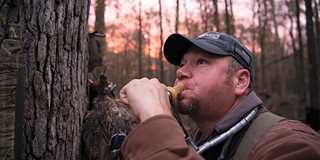Waterfowler's World: Timber Tactics
Expert advice for hunting this classic southern habitat
Expert advice for hunting this classic southern habitat

By Bill Buckley
My first experience hunting flooded timber was more than 20 years ago, and I'll never forget it. Just as the faint first light allowed us to see the oaks forming the perimeter of the small hole we occupied, more than 500 mallards suddenly descended. I remember the sound of wings raking branches and how loudly the hens called, but ducks plopping into the water literally inches away is my most indelible memory. I was mesmerized, to the point that I didn't even raise my gun when the shot was called.
Flooded timber is the everyday world of Rusty Creasey, manager and head guide at Coca-Cola Woods Duck Club in McCrory, Arkansas. And while he gets to enjoy such experiences each season, chances are he has far more days when decoying wary mallards is a real challenge.
Here are a few things that a lifetime of timber hunting has taught him.
Because you will usually be hiding next to a tree trunk, stick with gray-brown woods camouflage versus the lighter, yellow-brown marsh patterns. Mossy Oak Bottomland, Realtree Timber, and Natural Gear are hard to beat, although solid colors also work well. Just don't forget to stay still and cover your face. "Everyone likes to watch ducks working," Creasey says, "but shiny faces flare ducks. Hunters should wear face masks or face paint. I also like to place eight to 10 switch-cane stalks around the trees; they help break up hunter outlines and allow you to accommodate two hunters per tree."
Creasey likes to set up with the wind at his back. To ensure close shots and clean kills, he'll shift the decoy spread slightly downwind to open a landing zone between the decoys and the upwind edge of the hole. "I want ducks to overshoot the main spread and land tighter to where my hunters are," he explains. "Your landing hole should be big enough to make it easy for ducks to want to commit; about the size of a pickup truck and a half is perfect. I will place spinners there too, since ducks typically land next to them."
"Most timber hunters use about three dozen decoys and a couple of spinners," Creasey says. "I typically use six to seven dozen decoys with up to six spinners. On large holes I may use more. I want to give ducks something different from what they see in every other hole. I also like bright, colorful decoys, which are more visible on cloudy days and early in the season, when there's foliage on the trees."
Timber hunters traditionally kick the water with their boots to generate ripples, get the decoys moving, and create sounds like ducks splashing around. To add even more movement, Creasey will put five or six decoys on a jerk cord near the center of the spread. When he pulls hard, the resulting ripples cause most of his decoys to move. He also loops the jerk cord around the decoys' necks so they'll dip like feeding ducks.
"My number-one rule of calling," Creasey says, "is if ducks are doing what you want, don't call. Early season you can call more, and I do lots of feed calling then. Later in the season I only call on the corners, when ducks are upwind and flying into the wind, or when they are swinging around on the downwind side. When they're downwind, let them get far enough away so that when you hit the call hard, they can turn immediately for their final pass. I do very little feed calling in the late season, since they've heard plenty of it by then, and with no foliage it's more likely to draw attention to you than to make them commit. That's also why you shouldn't call to ducks directly overhead."

The keys to a successful timber hunt include effective concealment and judicious calling.
Photo © BILLBUCKLEYPHOTOGRAPHY.COM
By January, timber-loving mallards have learned to avoid the larger holes they readily worked earlier in the season. Creasey says hunters should seek out tiny openings-perhaps as small as a gap in the canopy where a tree or two has fallen. Be sure to bring your jerk cord, and if spinners aren't flaring birds, place them away from the opening, just inside the thick woods. You'll have the table set for some fantastic late-season timber action.
Ducks Unlimited uses cookies to enhance your browsing experience, optimize site functionality, analyze traffic, and deliver personalized advertising through third parties. By continuing to use this site, you agree to our use of cookies. View Privacy Policy